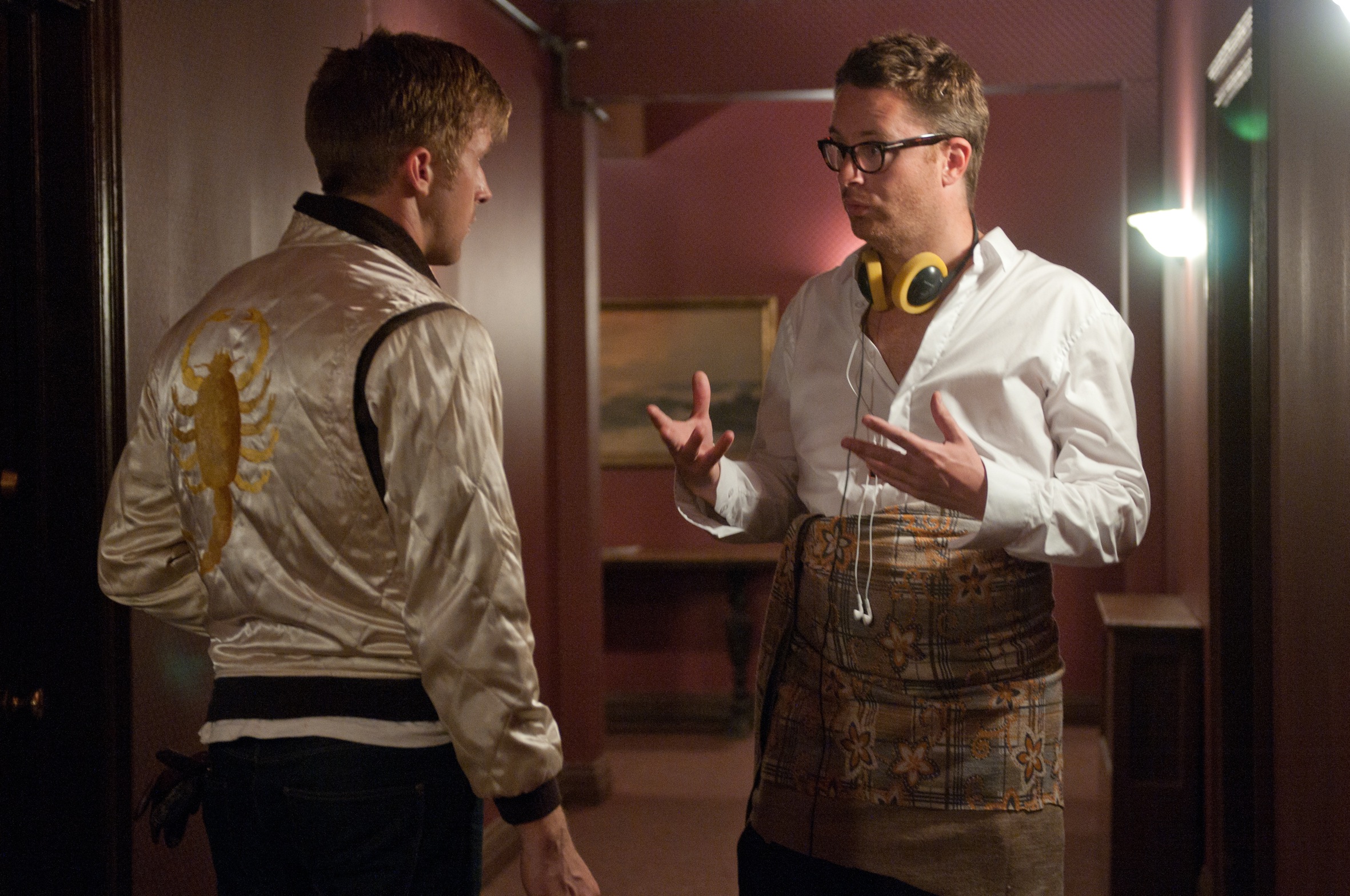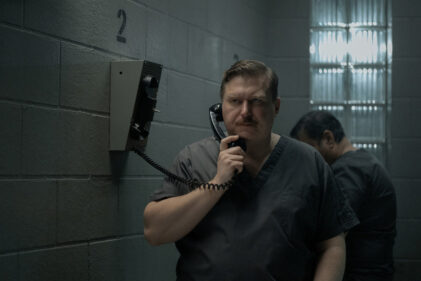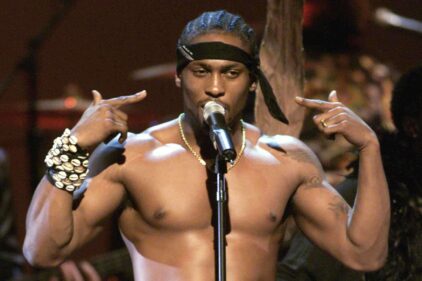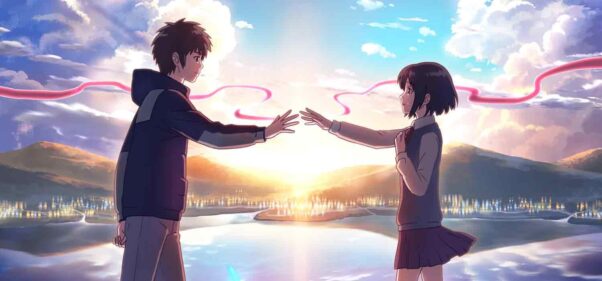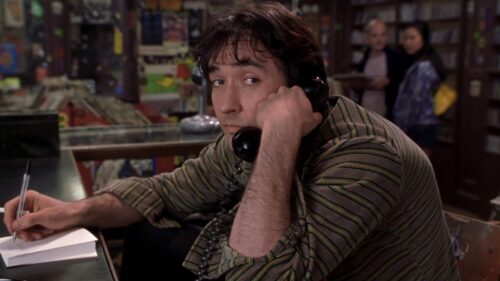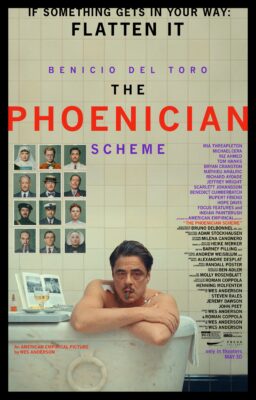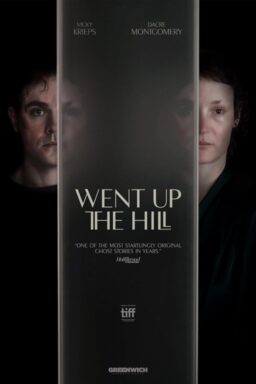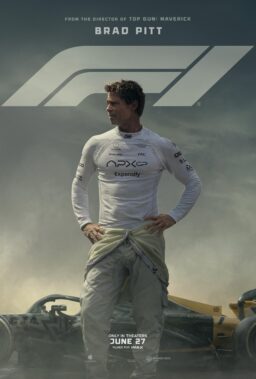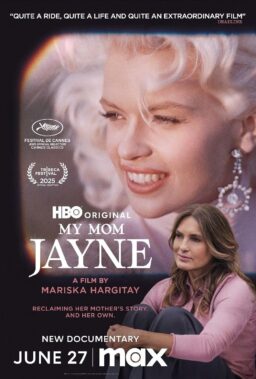Danish-born filmmaker Nicolas Winding Refn loves midnight movies. That affection shows in his most recent films. “Valhalla Rising,” a 2009 Viking epic featuring “Hannibal” star Mads Mikkelsen as a one-eyed warrior, is evocative of a certain kind of grindhouse-friendly arthouse cinema. Refn has described “Valhalla Rising” as a transitional film in his career. It’s been compared to everything from “The Last Movie” to “Aguirre, The Wrath of God.” Film Comment critic Jonathan Romney even wrote that “Valhalla Rising” is like, “Alejandro Jodorowsky pared down to a spartan minimalism, or John Milius stoned on some obscure Arctic fungus.”
“Only God Forgives,” Refn’s newest collaboration with Gosling, is a further extension of that midnight movie frame of mind. It was originally conceived as a “western set in contemporary Thailand,” and only got freakier from there. In the film, Gosling plays a drug-dealing Thai boxer whose psychotic gangster mom (Kristin Scott Thomas) demands that he face off with a merciless Thai police lieutenant (Vithaya Pansringarm).
This past Sunday , I co-hosted a double feature of “Valhalla Rising” and “The Telephone Book,” a recently rediscovered 1971 avant garde porno-comedy, at Williamsburg’s Videology theater.
Between films, Refn and I talked about his influences, how he puts his movies together, and what subjects he’s developing now: everything from Miami prostitutes to golden-lasso-wielding superheroines.
SA: You once called “Valhalla Rising” a “midnight movie from 1974.” What has been your experience watching midnight movies? Where did you see them, in Denmark?
Refn:I came to America when I was eight years old, and spent ten years of my life in New York. That was a period when New York was pretty hip in terms of its diversity. You had a lot of midnight shows, and alternative cinemas. Alternative filmmaking was really taking shape in New York at that time. So when I went to the movies, New York still had a lot to offer. I remember going to the Cinema Village and seeing double features, and experiencing midnight movies. I even remember seeing [The Adventures of Buckaroo Banzai Across the 8th Dimension] at a midnight show.

I like all kinds of film.I’m dyslexic, which means I have trouble reading and writing. So images really speak to me. I didn’t speak any English when I came to America, so visuals were the only way for me to really communicate for a long time. But I think the the biggest thing that changed my life, coming from Copenhagen to America, was television. In Copenhangen, there was only one channel, and it showed between 5 am and 10 pm . So coming to America and seeing television the way television was invented was an obsession. I had a fetish for television. I liked to touch them. The first thing I do when I go to people’s houses is look at their television, turn it on. Which is kind of ironic now because [the Cannes Film Festival], which is the high end of cinema culture, is now also showing digital projections. So you’re sitting in a big auditorium with people dressed in tuxedoes, and you’ve got everyone watching a giant television.
SA: You mentioned that you are a visual thinker. I’ve read that you block your images with the bottom of the frame in mind. When I was rewatching “Valhalla Rising” today, I noticed that there was a lot of peripheral extreme close-ups of Mads Mikkelsen. You’ve also said that your screnwriting process is, “organic screenwriting,” in that you write down on index cards the images you want to see in the film, just to see if they make up a film. What were the first images you had for this film, and how did you imagine them when you first got the screenwriter?
Refn:I don’t know if there are any filmmakers here, but this is how you survive in the film industry. Go to a distributor, and say, “Mads Mikkelsen, Viking, action, violence.” And they’ll says, “Sure, we’ll pay for that.” Then you get the money. And then you go to a really remote area where nobody wants to film. Then you say, “OK: what would I like to do today?” All my films are chronologically ordered not because I get very confused. But I like the constant evolution of seeing where the film is moving every day. And I put everything on index cards because I’m not a very good writer. But I’m a fetishist, so I sometimes have to do it myself. Because it’s sometimes hard to explain to other people about high heels, or women’s legs without being embarrassed. So the idea of putting everything on cue cards is so that you can constantly see everything unfolding.
In terms of framing: most photographers will tell you that framing is about looking at what’s in the top-right of the frame, or on your left. But if you look at painters, there hasn’t been a painter that doesn’t look to the bottom frame as much as they do the top frame. So to completely fulfill cinema, it’s very much what’s on top, and what’s on the bottom.

SA: Speaking of fetishism, when Ryan Gosling watched [“Valhalla Rising”], he decided he wanted to make “Drive” with you. He said that, in the scene, where Mads Mikkelsen rips the guy’s guts out, everyone in Gosling’s theater was going insane. He said that it was “a fun time” to be there for him.
And when I watch the now-infamous elevator scene in “Drive,” I get the sense that there is an alienating, Lynchian sense of humor there. Like you respect the action of the moment, but not the violence. It’s really striking because the most realistic part about “Valhalla Rising” is the introductory “Wrath” portion, which is also the most cartoonishly violent. So I wanted to talk about your sense of humor in these films. It is alienating, but it’s not Brechtian. It’s almost comic book-like. I know you’ve said that the only part of “Valhalla Rising” that you consider to be intentionally humorous is the scene where a character names Mikkelsen’s character “One-Eye,” explaining, “Well, you only have one eye!”
Refn:The distributor wanted something funny, so I made it a funny line.
SA: But the use of violence and the excess of it is pointed, no?
Refn: Well, the use of violence is … I guess art is an act of violence, in a way. It’s an emotional outpouring, and I don’t really know … I think that violence in the cinema is necessarily a fetish. Emotionally, our artistic expression consists of sex or violence. It all boils down to those two pure emotions that we have. But where erotica or sexuality is not fantasy, because most of us do it, violence, on the other hand, is fetish, is fantasy. There is a sexuality to violence that I find very intoxicating. But I think that that’s what turns me on.
SA: I mentioned the elevator scene because you’ve said that that scene is the key to that film. It’s not even a transition between Driver and what he needs to do, who he needs to become at that point. And he goes from stomping that guy’s head in, blood spurting everywhere—on the camera even—to kissing her. And then they get out of the elevator and everything’s fine.
Refn:Well…
SA: Ok, not everything’s fine.

Refn:Every film that you make has to have a scene that is the heart that blood flows through in every other scene. That scene doesn’t always have to be in the beginning of the film. But it can also be at the end, or in the middle, and that can sometimes make the film more effective. The Driver character is similar to the title character in a film I made called “Bronson,” which is also about transformation. It’s about a man transforming himself into what he was meant to be. Originally, the elevator scene was more conventional. They were going to meet in an elevator, a hitman was going to step out, they were going to meet Irene [Carey Mulligan’s character], go down to the parking lot. And the hitman was going to come in and shoot at her, and then Driver was going to push her away to safety. We tried it out on location, and it was so boring. My editor, Matt Newman, suggested that we change locations.
I asked, “Well, what can we do?”
He said, “Well, remember there’s that [Takeshi Kitano] movie with the shoot-out in the elevator. What about finding a space for that? Then in a way, he can kiss her before smashing the guy’s head in.” And I shot that slow motion while the light in the elevator dims. Is the kiss that they had real, or just a fantasy in his head? It was also for him to separate himself from her. So it’s ultimate love, in a way. The American producers just didn’t understand the light-cue thing.”Why would the lights dim?!” “Well, it’s poetic, and the camera moves in…”
But anyway. The line producer came down and saw what we were doing. He thought there was something wrong with the electricity. I had to explain what poetry meant in Europe.
SA: I know that for “Valhalla Rising,” you had some difficulty setting up certain shots because you’re filming [in Scotland] on uneven terrain. But it doesn’t feel like a Dennis Hopper/”The Last Movie”-type film, in that the camerawork is rough. In fact, the camerawork is serene. It has a [Terrence] Malick-like feel to it.
Unlike “Drive,” where you had Ryan Gosling show you around [Los Angeles], you don’t have someone to show you landmarks. It’s all pretty much a uniform landscape. So who is giving you the lay of the land here? Were you just figuring it out for yourself?

Refn:Well, once you get the money from the distributor, and you go away, it becomes more like…well, I have no interest in Vikings. I don’t know anything about them, and I find them really stupid. So I listened to these experts talk about Vikings, and Viking ships, and it’s very fascinating. And I was like, [pretends to fall asleep] “This is so geeky.”
But these experts’ obsession was, at the same time, very interesting. I like people that are obsessed with things. But when we got to Scotland, I had just done “Bronson.” I was doing these two films back-to-back, pretty much. And then I went from “Drive” to “Only God Forgives” almost right away. I just think that when you’re in nature, it’s tricky, because everything is beautiful. So I wanted to shoot everything like it was a wax museum, like they were in Madam Tussaud’s Wax Museum.
Somebody gave me the Bible in images, and everyone in it was stoic. And “Valhalla Rising” does take place in a time when there was religious turmoil in Europe. Christianity was basically moving in, and annihilating other religions. And from that, came this belief that became Christianity.
SA: My friend [film critic Steve Carlson] was just reminding that there’s a reference to “Aguirre, The Wrath of God” in this film. And it’s so obvious that, like me, he didn’t see it until we rewatched the film today. It’s in that scene where one Viking gets hit with an arrow by someone off-screen. And speaking of fetishism, and respecting people for being obsessives–to me, that’s very much like a Herzog film.
But as you said, in this film your protagonist is stoic. So there is no way to know about the internal logic of why he does anything. This is unlike “Drive,” which as you said, is like a fractured fairy tale because there’s a role Driver has to assume, and then there’s the fairy tale life that he’d like to have. To get to that, there are two layers to the character, and a disconnect between them.
But here, all the action is on the film’s surface. You find the mystery in that. Because this film is a transitional film for you, how did you go from “Bronson” to this?

Refn:After I’ve done a movie, I try to erase all memory of it. The fear factor of repeating myself, or knowing that if it’s a success, you’ll seek that success again. So I tried to eliminate all thoughts of what worked, so the next film is a blank canvas. It’s almost as if when I make a movie, I say, “This could be my last movie, so I’ll go out with a bang.”
And of course, halfway through shooting, you really like it, and then you start to panic. The idea though is that things have to be different. You always have to challenge yourself. “Bronson” was essentially a gay opera. It was! And “Valhalla Rising” had to be something completely different this time.
After “Valhalla Rising,” I was supposed to do “Only God Forgives.” But then I got offered a Paul Schrader script, “The Dying of the Light.” They asked if I’d like to do it, and agreed. First, we were going to cast Robert DeNiro. I came to New York, and met with him for like, 10 seconds. And he said, “I don’t wanna do the movie.” Well, he could have told me that before I came here!
So ok, who would I like instead? Well, Harrison Ford would be cool. Harrison Ford saw “Bronson”—didn’t like it. Forget that one. But he did see some of my Danish films, which I think he did respond to, especially “Pusher II: With Blood on My Hands,” especially the father-son relationship. So he said, “I’ll do the movie.” And I thought great, but the character has to die. So my contribution to cinema was going to be killing Harrison Ford. But he didn’t like that, so it didn’t happen.
And then “Drive” came, and I thought, “You know what? I’m going to make ‘Drive’ because I came from Scotland, and I want to go to Los Angeles, and make a movie about a car.” Because I don’t know how to drive a car. So you have to find an obstacle that forces you to be creative. Because art is about turning your weaknesses into your strengths. Because art is an expression of so many things, perfection is the enemy. So you have to find something you’re not good at, and turn that weakness into your strength. That’s my creative process.
SA: That concept of art as an act of violence seems like a very [Alejandro] Jodorowsky-esque concept. It seems like something he might have even said at one point. You dedicated your new film to Jodorowsky. And that new documentary about the version of “Dune” that he wanted to make mentions that you saw the holy book of art designs for his “Dune.” So I’m curious: what do you take form his films?
Refn:I meant Jodorowsky four years ago in Paris. And that was pretty groovy. I went to his house for a tarot reading, and dinner. And I remember my question was, “Should I make ‘Drive?'” And he gave me a tarot reading, and said, “You will travel with this movie.”

“Is that a yes or no?” I took it as a yes.
And after that we became quite close friends.
I’ve always admired his work in many different ways. If you’re ever in creative doubt, or feel you’re getting too secure, just watch a Jodorowsky movie, and you’ll think, “This is what I have to do.” What’s interesting about him is he goes against all kinds of conventions about what filmmaking is supposed to be. Then he christened me his spiritual god-son. Which I thought was kind of bizarre. But then it became my routine to go to Paris, and visit him.
So one night, he said, “You want to see’Dune?'”
Ah, but I did!
And then he showed me this very famous storybook. The book is about this big [pantomimes a book the size of a phonebook], and this wide. And it was every single frame from his version. And I had Jodorowsky narrating the film for me. So it was like a midnight screening of “Dune.”
By the way, the new documentary [about Jorodorwsky’s never-filmed version of “Dune”] is fantastic. It’s a very interesting film because it also shows his influence on science fiction from then on. Just like his “El Topo.” There would be no pop cinema without Jodorowsky. No me, no Robert Rodriguez, no Quentin Tarantino, no Gaspar Noe without “El Topo.”
SA: It’s also credited with being the first real midnight movie, too, which brings us back full circle.
I want to also talk about your new film, though. When I interviewed you last time, “Valhalla Rising” was just come out here. You described “Only God Forgives” as a western set in Thailand. Having seen the film, I can say that it’s markedly different than a western. If it were like a western, it’d have to be like “Duel in the Sun,” something very oneiric, or dreamlike. I’m curious how you get from the concept of a western to the film we’ll see on Friday.
Refn:Well, it all started…I asked a friend of mine what the average French film cost. She said six million Euros. That’s an average French-budgeted movie. I went to Paris and I met with Wild Bunch, and I said, “I’ll give you two movies for 6 million, and I’ll make them genre movies.”
“Ok, we’ll put up half the money. If you can get the other half, we’ve got a deal. But what’s your synopsis of your first film?”
“Well, I’ll make a western!”
“Ok.”
“In Asia!”
“Ok.”
“A fight movie!”
“Ok, great, deal.”
So that’s how the movie was set up. And when I had the money, I thought, “Well, what do I really want to do now?”
SA: I’ve read that your next project with Wild Bunch is something called “I Walk with the Dead,” based in Miami, in the world of prostitution?
Refn:Well, I had to sell something really quick, so I just said that. France, catchy title…”Deal!” It’s not going to be that. I don’t know when I’ll make it. I’m concentrating on my TV show right now, called, “Barbarella.” But then I’ll probably go back to L.A. to make another film. I really like to work in L.A.
SA: You were also talking about remaking “Logan's Run,” but you also said that you had ideas for doing a “Wonder Woman” movie. Is there a possibility for a Nic Refn “Wonder Woman” movie?
Refn:No. But that was because I love “Logan’s Run.” I said to Ryan, “Let’s go and make ‘Logan’s Run.'” So we said that we’d started the process, and were working on the script. Ryan said OK, and if Ryan wants to do “Logan’s Run,” we’ll do “Logan’s Run!”
But then I realized—and he also had his own opinions about this—maybe this wasn’t the best solution. So we both pulled out of it. It was a similar decision when we were talking about “Wonder Woman.” They said, “You do ‘Logan’s Run,’ then we’ll talk about ‘Wonder Woman.'” But then I decided to do “Barbarella” instead.
SA: Where are you with that?
Refn:I’m writing it right now with some other writers. We’ll see where it goes from there.

